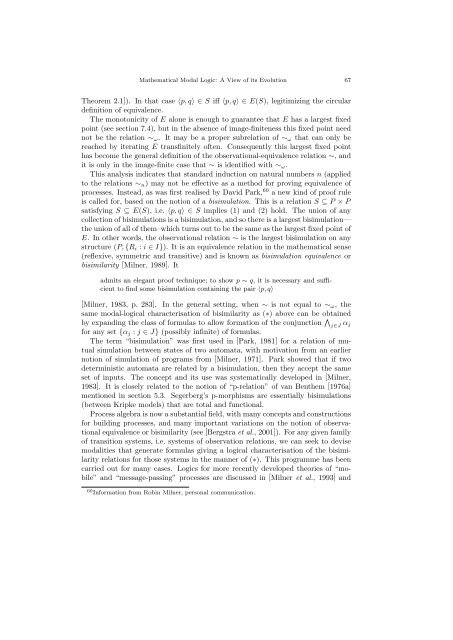MATHEMATICAL MODAL LOGIC: A VIEW OF ITS EVOLUTION
MATHEMATICAL MODAL LOGIC: A VIEW OF ITS EVOLUTION
MATHEMATICAL MODAL LOGIC: A VIEW OF ITS EVOLUTION
You also want an ePaper? Increase the reach of your titles
YUMPU automatically turns print PDFs into web optimized ePapers that Google loves.
Mathematical Modal Logic: A View of its Evolution 67Theorem 2.1]). In that case 〈p, q〉 ∈ S iff 〈p, q〉 ∈ E(S), legitimizing the circulardefinition of equivalence.The monotonicity of E alone is enough to guarantee that E has a largest fixedpoint (see section 7.4), but in the absence of image-finiteness this fixed point neednot be the relation ∼ ω . It may be a proper subrelation of ∼ ω that can only bereached by iterating E transfinitely often. Consequently this largest fixed pointhas become the general definition of the observational-equivalence relation ∼, andit is only in the image-finite case that ∼ is identified with ∼ ω .This analysis indicates that standard induction on natural numbers n (appliedto the relations ∼ n ) may not be effective as a method for proving equivalence ofprocesses. Instead, as was first realised by David Park, 60 a new kind of proof ruleis called for, based on the notion of a bisimulation. This is a relation S ⊆ P × Psatisfying S ⊆ E(S), i.e. 〈p, q〉 ∈ S implies (1) and (2) hold. The union of anycollection of bisimulations is a bisimulation, and so there is a largest bisimulation—the union of all of them–which turns out to be the same as the largest fixed point ofE. In other words, the observational relation ∼ is the largest bisimulation on anystructure (P, {R i : i ∈ I}). It is an equivalence relation in the mathematical sense(reflexive, symmetric and transitive) and is known as bisimulation equivalence orbisimilarity [Milner, 1989]. Itadmits an elegant proof technique; to show p ∼ q, it is necessary and sufficientto find some bisimulation containing the pair 〈p, q〉[Milner, 1983, p. 283]. In the general setting, when ∼ is not equal to ∼ ω , thesame modal-logical characterisation of bisimilarity as (∗) above can be obtainedby expanding the class of formulas to allow formation of the conjunction ∧ j∈J α jfor any set {α j : j ∈ J} (possibly infinite) of formulas.The term “bisimulation” was first used in [Park, 1981] for a relation of mutualsimulation between states of two automata, with motivation from an earliernotion of simulation of programs from [Milner, 1971]. Park showed that if twodeterministic automata are related by a bisimulation, then they accept the sameset of inputs. The concept and its use was systematically developed in [Milner,1983]. It is closely related to the notion of “p-relation” of van Benthem [1976a]mentioned in section 5.3. Segerberg’s p-morphisms are essentially bisimulations(between Kripke models) that are total and functional.Process algebra is now a substantial field, with many concepts and constructionsfor building processes, and many important variations on the notion of observationalequivalence or bisimilarity (see [Bergstra et al., 2001]). For any given familyof transition systems, i.e. systems of observation relations, we can seek to devisemodalities that generate formulas giving a logical characterisation of the bisimilarityrelations for those systems in the manner of (∗). This programme has beencarried out for many cases. Logics for more recently developed theories of “mobile”and “message-passing” processes are discussed in [Milner et al., 1993] and60 Information from Robin Milner, personal communication.
















